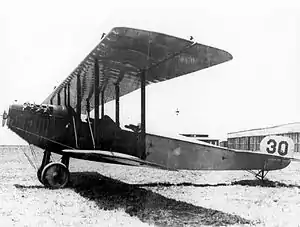Curtiss Model J
The Curtiss Model J (along with the Curtiss Model N) was a prototype tractor configuration aircraft that became the basis for the Curtiss Jenny series of aircraft.
| Curtiss Model J | |
|---|---|
 | |
| Curtiss J Tractor, Signal Corps No. 30, Rockwell Field, California | |
| Role | Biplane |
| National origin | United States of America |
| Manufacturer | Curtiss Aeroplane Company |
| Designer | Benjamin D. Thomas |
| First flight | 12 March 1914 |
| Introduction | 1914 |
| Number built | 2 |
Development
The Curtiss J was designed by Benjamin D. Thomas. Glenn Curtiss hired Thomas from the Sopwith Aviation Company while on a trip to London, England. He started designing the Model J while overseas, and is also credited with helping design the Model N and the Model H "America".[1][2] The first flight tests were performed without fuselage covering.[3] In February 1914, after a series of accidents with pusher aircraft, the U.S. Army held a meeting in San Diego expressing interest in tractor design aircraft such as the Model J[4][5]
Design
The Model J had the engine mounted on the nose of the aircraft with a tractor propeller and was covered with clear doped linen or cotton, with tandem seating and conventional landing gear with a tailskid.[6] The biplane wings were built without dihedral and the upper wing was considerably greater in span than the lower and fitted with ailerons.[7] The Curtiss Model J S.C. No. 30 became the testing prototype for the JN, earning the title as the first "Jenny".
Operational history
The first prototype was rolled out on 12 March 1914. It was delivered to the Aviation Section, U.S. Signal Corps on 28 July. At the time the entire United States military air fleet consisted of 23 aircraft.[8]
- 1914 In September, pilot Lewis E. Goodier, Jr. achieved a record climb rate for an aircraft of 1000 ft per minute. Later that month the Model J would become the fastest aircraft in America with a recorded speed of 85.7 mph [9]
1914 October 8, SN30 flown by Capt. H. Le R. Muller reached a record altitude of 17,441 ft [10]
- 1915 Both model J aircraft crashed in testing.
Variants
- A Model J was demonstrated with floats in 1915 at Keuka Lake[11]
- Curtiss J-2 - A smaller design of the Model J, cancelled.
- Curtiss Model N - The first prototype was built off a Model J modified in Hammondsport, New York.[12]
Specifications (Curtiss Model J)
Data from Curtiss Aircraft 1907–1947[13]
General characteristics
- Crew: two
- Length: 26 ft 4 in (8.03 m)
- Wingspan: 40 ft 2 in (12.24 m)
- Wing area: 340 sq ft (32 m2)
- Empty weight: 1,075 lb (488 kg)
- Gross weight: 1,635 lb (742 kg)
- Powerplant: 1 × Curtiss OX-2 , 90 hp (67 kW)
Performance
- Maximum speed: 70 mph (110 km/h, 61 kn)
- Endurance: 4 hr
- Time to altitude: 10 min to 3,000 ft (915 m)
References
| Wikimedia Commons has media related to Curtiss Model J. |
- Notes
- Peter M. Bowers. Curtiss aircraft, 1907-1947.
- Bill Yenne. The Pictorial History of American Aircraft.
- Aircraft in profile, Volume 2. Doubleday.
- Norman Polmar; Dana Bell. One hundred years of world military aircraft.
- John C. Fredriksen. The United States Air Force: A Chronology.
- Andrew W. Waters. All the U.S. Air Force airplanes, 1907-1983.
- Grover Cleveland Loeing. Military aeroplanes: an explanatory consideration of their characteristics.
- Air Force History Research Agency, Maxwell AFB, Alabama. The United States Army Air Arm, April 1861 to April 1917, Air Force Historical Study No. 98.CS1 maint: multiple names: authors list (link)
- Anthony Robinson. The Illustrated encyclopedia of aviation, Volume 6.
- Cornélis De Witt Willcox. The International military digest annual, Volume 2.
- Aerospace Industries Association of America. Aircraft yearbook.
- Flying, Volumes 62-63. Missing or empty
|title=(help) - Bowers 1979, p. 65.
- Bowers, Peter M. Curtiss Aircraft 1907–1947. London:Putnam, 1979. ISBN 0-370-10029-8.
- "The Curtiss Tractor Biplanes". Flight. VI (50): 1191–1192. 11 December 1914. (Describes both the Model J and the Model N.)
- "Curtiss Model 'J' Tractor Biplane". Aeronautics. XV (5): 69. 15 September 1914.
- "Remarkable Demonstration of the Curtiss Military Tractors". Flying. III (9): 264. October 1914.